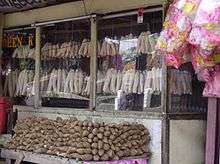Tapai
|
Packaged tapai paste made from cassava in Indonesia | |
| Alternative names | Peuyeum, etc. |
|---|---|
| Type | Rice wine, alcoholic paste |
| Region or state | South Asia, East Asia, South East Asia |
| Main ingredients | Usually white rice, glutinous rice |


Tapai (also tapay or tape), is traditional fermented rice found throughout much of Southeast Asia and parts of East Asia, especially in Austronesian cultures. It refers to both the alcoholic paste and the alcoholic beverage derived from it. It has a sweet or sour taste[1] and can be eaten as is, as ingredients for traditional recipes, or fermented further to make rice wine (which in some cultures are also called tapai). Tapai is traditionally made with white rice or glutinous rice, but can also be made from a variety of carbohydrate sources, including cassava and potatoes.[1][2] Fermentation is performed by a variety of moulds including Aspergillus oryzae, Rhizopus oryzae, Amylomyces rouxii or Mucor species, and yeasts including Saccharomyces cerevisiae, and Saccharomycopsis fibuliger, Endomycopsis burtonii and others, along with bacteria.[1][2]
Etymology
Tapai is derived from Proto-Malayo-Polynesian *tapay ("fermented [food]"), which in turn is derived from Proto-Austronesian *tapaJ ("fermented [food]"). Derived cognates has come to refer to a wide variety of fermented food throughout Austronesia, including yeasted bread and rice wine.[3][4]
Proto-Malayo-Polynesian *tapay-an also refers to large earthen jars originally used for this fermentation process. Cognates in modern Austronesian languages include tapayan (Tagalog), tepayan (Iban), and tempayan (Javanese and Malay).[3][4]
Starter culture
Tapai is made by inoculating a carbohydrate source with the required microorganisms in a starter culture. This culture has different names in different regions, shown in the table below. The culture can be naturally captured from the wild, by mixing rice flour with ground spices (include garlic, pepper, chili, cinnamon), cane sugar or coconut water, slices of ginger or ginger extract, and water to make a dough.[2] The dough is pressed into round cakes, about 3 cm across and 1 cm thick, and left to incubate on trays with banana leaves under and over them for two to three days. They are then dried and stored, ready for their next use.
| Region | China | Indonesia/Malaysia | Korea | Philippines | Thailand |
|---|---|---|---|---|---|
| Name | peh-chu, jiuyao (simplified Chinese: 酒药; traditional Chinese: 酒藥; pinyin: jiǔyào; Jyutping: zau2joek1) | ragi tapai | nuruk | bubod, tapay | look-paeng |
Preparation

Tapai is used to ferment different types of carbohydrates such as cassava, cooked white rice or glutinous rice, and sometimes sweet potatoes. The general process is to wash and cook the target food, cool to about 30 °C, mix in some powdered starter culture, and rest in covered jars for one to two days. With cassava and sweet potato, the tubers are washed and peeled before cooking, then layered in baskets with starter culture sprinkled over each layer.
The finished tapai will taste sweet with a little alcohol, and can be consumed, or left for several days more to become sour.
| Region | Cambodia | China | India | Indonesia | Korea | Malaysia | Philippines | Singapore | Thailand | Brunei |
|---|---|---|---|---|---|---|---|---|---|---|
| white rice | chao, tapai | lao-chao (Chinese: 醪糟; pinyin: láozāo; Jyutping: lou4zou1), Jiuniang | tapai beras | nuruk | tapai nasi | binuburang basi, tapay basi | tapai nasi | khao-mak | tapai | |
| glutinous rice | tapai | Bhattejaanr | tapai ketan | tapai pulut[5] | pulut | |||||
| cassava | tapai ketela, tapai ubi kayu (Minangkabau), tape singkong, tape telo, peuyeum (Sundanese) |
tapai ubi kayu | binuburang ube, tapay panggi |
Uses in cuisine
Tapai and its variants are usually consumed as it is; as a sweet mildly-alcoholic snacks, to accompany tea in the afternoon. The sweet fermented tapai however, are often used as the ingredient in a recipe of certain dishes. Sundanese cassava peuyeum is the main ingredient for colenak; a roasted fermented cassava tapai served with kinca a sweet syrup made of grated coconut and liquid palm sugar. Colenak is Sundanese portmanteau of dicocol enak which translates to "tasty dip". Tapai uli is a roasted block of bland-tasted ketan or pulut (glutinous rice) served with sweet tapai ketan or tapai pulut. The peuyeum goreng or tapai goreng, or known in Javanese as rondho royal is another example of Indonesian gorengan (assorted fritters), which is deep fried battered cassava tapai.
In beverages, tapai, both cassava or glutinous rice, might be added into sweet iced concoction desserts, such as es campur and es doger.
See also
References
- 1 2 3 Norman F. Haard; et al. (1999). "Fermented Cereals. A Global Perspective". United Nations FAO.
- 1 2 3 Indrawati Gandjar (August 2003). "TAPAI from Cassava and Cereals" (PDF). University of Indonesia. Archived from the original (PDF) on 2005-01-26. Retrieved 2006-07-28.
- 1 2 Blust, Robert; Trussel, Stephen. "Austronesian Comparative Dictionary: *t". Austronesian Comparative Dictionary. Retrieved 21 June 2018.
- 1 2 Fitrisia, Dohra; Widayati, Dwi (2018). "Changes in basic meanings from Proto-Austronesian to Acehnese". Studies in English Language and Education. 5 (1): 114–125. doi:10.24815/siele.v5i1.9431.
- ↑ Keith Steinkraus (26 March 2004). Industrialization of Indigenous Fermented Foods, Revised and Expanded. CRC Press. pp. 247–. ISBN 978-0-8247-4784-8.
External links
| Wikimedia Commons has media related to Tapai. |
| Wikibooks Cookbook has a recipe/module on |